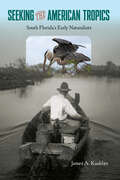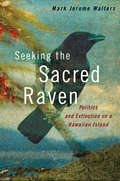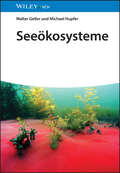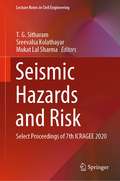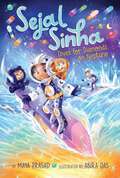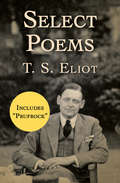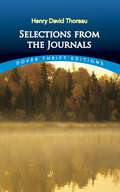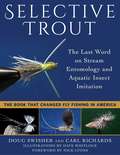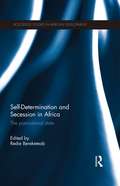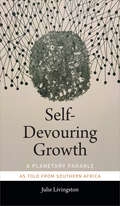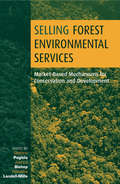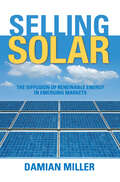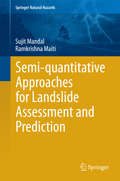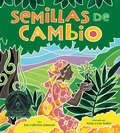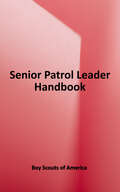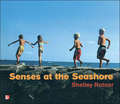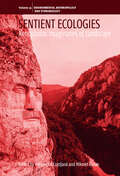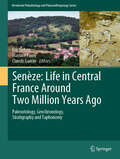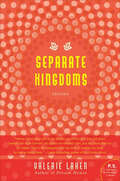- Table View
- List View
Seeking the American Tropics: South Florida's Early Naturalists
by James A. KushlanFor centuries, the southernmost region of the Florida peninsula was seen by outsiders as wild and inaccessible, one of the last frontiers in the quest to understand and reveal the natural history of the continent. Seeking the American Tropics tells the stories of the explorers and adventurers who—for better and for worse—helped open the unique environment of South Florida to the world.Beginning with the arrival of Juan Ponce de León in 1513, James Kushlan describes how most of the famous Spanish explorers never made it to South Florida, leaving the area’s rich natural history out of scientific records for the next 250 years. It wasn’t until the British colonial and early American periods that the first surveyors were commissioned and the first naturalists—Titian Peale and John James Audubon—arrived to collect, draw, and report the subtropical flora and fauna that were so unique to North America.Moving into the railroad era, Kushlan illuminates the activities of scientists such as Henry Nehrling and Charles Torrey Simpson alongside the dabbling of wealthy amateur naturalists. He follows the story to the 1920s, when tourism was flourishing and signs of ecological damage were starting to show. Years of wildlife trade, resource extraction, invasive species introduction, and swamp drainage had taken their toll. And many of the naturalists who had been outspoken about protecting South Florida’s environment had also played a part in its destruction.Today the region is among one of the most thoroughly studied places on the planet—but at a cost. In this absorbing and cautionary tale, Kushlan illustrates how exploration has so often trumped conservation throughout history. He exposes how much of the natural world we have already lost in this vivid portrait of the Florida of yesterday.
Seeking the Sacred Raven: Politics and Extinction on a Hawaiian Island
by Mark Jerome WaltersWill the 'Alala ever return to the wild? A bird sacred to Hawaiians and a member of the raven family, the 'Alala today survives only in captivity. How the species once flourished, how it has been driven to near-extinction, and how people struggled to save it, is the gripping story of Seeking the Sacred Raven. For years, author Mark Jerome Walters has tracked the sacred bird's role in Hawaiian culture and the indomitable 'Alala's sad decline. Trekking through Hawaii's rain forests high on Mauna Loa, talking with biologists, landowners, and government officials, he has woven an epic tale of missed opportunities and the best intentions gone awry. A species that once numbered in the thousands is now limited to about 50 captive birds. Seeking the Sacred Raven is as much about people and culture as it is about failed policies. From the ancient Polynesians who first settled the island, to Captain Cook in the 18th century, to would-be saviors of the 'Alala in the 1990s, individuals with conflicting passions and priorities have shaped Hawaii and the fate of this dwindling cloud-forest species. Walters captures brilliantly the internecine politics among private landowners, scientists, environmental groups, individuals and government agencies battling over the bird's habitat and protection. It's only one species, only one bird, but Seeking the Sacred Raven illustrates vividly the many dimensions of species loss, for the human as well as non-human world.
Seeökosysteme
by Walter Geller Michael HupferSeen sind ein zentraler Bestandteil der mitteleuropäischen Landschaften mit einem hohen Nutzwert für Wasserversorgung, Binnenfischerei, Freizeit und Artenschutz. Sie besitzen ein komplexes Ökosystem, das von vielen unterschiedlichen Faktoren wie Temperatur, Nährstoffeintrag sowie der Art und Anzahl der im See lebenden Mikroorganismen, Pflanzen und Tiere abhängt. Die Kenntnis aller dieser Faktoren und ihres Zusammenspiels ist die entscheidende Voraussetzung, um das Ökosystem See zu verstehen, zu überwachen und ggf. schützend einzugreifen, wenn dieses aus der Balance gerät. Diese umfassende Übersicht zur Ökologie von Seen basiert auf neuesten Erkenntnissen und zahlreichen wissenschaftlichen Studien aus den vergangenen zwei Jahrzehnten. Zunächst werden die abiotischen Faktoren wie Temperatur, Licht und Sauerstoffverhältnisse und deren Einfluss auf die Gliederung von Seen in unterschiedliche Habitate und ökologische Nischen beschrieben. Weitere Kapitel befassen sich mit den Organismen im See, vom Phytoplankton und Zooplankton bis hin zu höheren Pflanzen und Tieren, deren Populationsbiologie, sowie den daraus entstehenden ökologischen Netzen. Der Einfluss invasiver Arten wird anhand von mehreren Beispielen dokumentiert. Dieses Standardwerk zur Ökologie von Seen erklärt und dokumentiert anhand von umfangreichem Datenmaterial den Stand des Wissens und ist ein zuverlässiger Begleiter für Ausbildung und Beruf.
Seismic Hazards and Risk: Select Proceedings of 7th ICRAGEE 2020 (Lecture Notes in Civil Engineering #116)
by T. G. Sitharam Sreevalsa Kolathayar Mukat Lal SharmaThis volume presents select papers presented at the 7th International Conference on Recent Advances in Geotechnical Earthquake Engineering and Soil Dynamics. The papers discuss advances in the fields of soil dynamics and geotechnical earthquake engineering. Some of the themes include seismic risk assessment, engineering seismology, wave propagation, remote sensing applications for geohazards,engineering vibrations, etc. A strong emphasis is placed on connecting academic research and field practice, with many examples, case studies, best practices, and discussions on performance based design. This volume will be of interest to researchers and practicing engineers alike.
Seize the Fire
by Laura KinsaleA scoundrel is transformed by the love of an innocent princess in this historical romance by the New York Times–bestselling author of Flowers from the Storm. Summoned to rule the tiny nation of Oriens, Princess Olympia St. Leger appoints the most celebrated man in England to escort her: recently retired war hero Capt. Sheridan Drake. Easily frightened, she is vastly relieved to have Captain Drake&’s help—until she discovers he&’s a scoundrel without a drop of honor in his body. In fact, nothing would make her happier than to forget him. Except she cannot seem to get his deep, stirring gaze out of her head . . . Sheridan has no patience for hero worshipers; war is a game of survival, not gallant deeds. But Olympia, who comes to him with plump cheeks and eyes full of expectation, has money, something of which he is in great need. And though Olympia is impossibly naive, for reasons he can&’t fathom, she touches him in some obscure, half-forgotten place, until the thought of losing her becomes even more impossible. Set in Georgian England, Seize the Fire is another exciting tale from the author of For My Lady&’s Heart, whose work has been praised by Julia Quinn as &“unfailingly brilliant and beautiful.&”
Sejal Sinha Battles Superstorms (Sejal Sinha #1)
by Maya PrasadThe Magic School Bus meets Over the Moon in this first book in a new chapter book series about a young Indian American girl who loves science and has a big imagination!Sejal Sinha is looking forward to celebrating Diwali with her family. But when a hurricane appears, Sejal and her cousin Mira learn that the house is in danger from the imminent storm. With the help of Sejal&’s favorite stuffed animal, Professor Cheetah, the two girls use Cardboard Box Magic to build their own Hurricane Hunter and fly into the eye of the hurricane! They learn about a project from the 1960s called Project Stormfury, where a team actually tried to stop hurricanes. Can Sejal and Mira do what the previous Stormfury team couldn&’t and battle the superstorm?
Sejal Sinha Dives for Diamonds on Neptune (Sejal Sinha #3)
by Maya PrasadIn the third book in the chapter book series about a young Indian American girl who loves science and has a big imagination, Sejal and the gang soar through outer space—perfect for fans of The Magic School Bus and Over the Moon!Sejal&’s puppy eats the page in her notebook with her best ideas. Her little brother throws a tantrum over string cheese. Sometimes, Sejal wishes she could escape being a big sister. After an embarrassing snot incident, her older cousin Ash is ready to leave the planet, too. Ash has been working on a very cool science project about a theory that it rains diamonds on Neptune. Treasure hunting on another planet sounds like the perfect out-of-this world adventure to Sejal! But getting to Neptune might be harder than she and Ash think, especially when they find a couple of stowaways in their spaceship…
Select Poems: Selected Poems (Faber Poetry Ser.)
by T. S. EliotAn essential collection of classic poems by the father of modernist poetry. In the masterly cadence of T. S. Eliot&’s verse, the twentieth century found its definitive poetic voice, an incredible &“image of its accelerated grimace,&” in the words of Eliot&’s friend and mentor Ezra Pound. This twenty-four-poem volume is a rich collection of Eliot&’s greatest works—including the classic &“The Love Song of J. Alfred Prufrock&”—all of which unveil the desires, grievances, failures, and heart of modern humanity. This collection includes &“Gerontion,&” &“Burbank with a Baedeker: Bleistein with a Cigar,&” &“Sweeney Erect,&” &“A Cooking Egg,&” &“Le Directeur,&” &“Mélange Adultère de Tout,&” &“Lune de Miel,&” &“The Hippopotamus,&” &“Dans le Restaurant,&” &“Whispers of Immortality,&” &“Mr. Eliot&’s Sunday Morning Service,&” &“Sweeney Among the Nightingales,&” &“The Love Song of J. Alfred Prufrock,&” &“Portrait of a Lady,&” &“Preludes,&” &“Rhapsody on a Windy Night,&” &“Morning at the Window,&” &“The Boston Evening Transcript,&” &“Aunt Helen,&” &“Cousin Nancy,&” &“Mr. Apollinax,&” &“Hysteria,&” &“Conversation Galante,&” and &“La Figlia Che Piange.&” This ebook has been professionally proofread to ensure accuracy and readability on all devices.
Selections from the Journals: An Annotated Selection From The Journal Of Henry D. Thoreau (Dover Thrift Editions: Philosophy Ser.)
by Henry David Thoreau Walter HardingNoted Thoreau scholar offers rich selection of favorite excerpts from voluminous Journals. Masterly meditations on man, society, nature and many other subjects--expressed with verve and vigor in some of the most poetic prose in American literature. Perfect introduction to the great naturalist and his thought. Introduction.
Selective Trout: The Last Word on Stream Entomology and Aquatic Insect Imitation (Lyons Press Ser.)
by Nick Lyons Carl Richards Dave Whitlock Doug SwisherWhen it was originally published in 1971, Selective Trout was universally acclaimed as the most revolutionary approach to aquatic insect imitation in the twentieth century. Using common sense, science, and imagination, authors Doug Swisher and Carl Richards developed a wide array of new patterns that were in sharp contrast to those offerings used by American fly fishermen up to that time. Their radical no-hackle dry fly, in particular, proved to be a more convincing, natural silhouette than anything anglers had ever seen before. With hatch charts covering different regions of the country, and featuring detailed tying instructions for flies that could be used in those regions, all liberally illustrated, the book provided anglers with a new arsenal of deadly fly patterns. Thirty years later, and after more than 200,000 copies of the first edition had been sold, a Thirtieth Anniversary Edition was brought out. Updated and revised by the authors, with new observations on trout behavior as well as detailed instructions on how to keep useful fishing logs, the book also featured detailed appendices on terrestrials, mayflies, caddisflies, and stoneflies. Not only that, but the new edition included hundreds of color illustrations by the renowned artist and fly-fishing innovator Dave Whitlock. It’s hard to imagine how anything could top that. In this new paperback edition of Selective Trout we know that we can’t top what’s been done previously. But we do know that this deserves to stay in print, because it’s the type of book that every fly fisherman should own and read. To add a new twist to this new edition, what we have done is added a new introduction by Doug Swisher (Carl Richards passed away in 2006), plus a new foreword by Nick Lyons, the book publisher who had the foresight to get behind the book in the first place.
Self-Determination and Secession in Africa: The Post-Colonial State (Routledge Studies in African Development)
by Redie BereketeabThis book provides a unique comparative study of the major secessionist and self-determination movements in post-colonial Africa, examining theory, international law, charters of the United Nations, and the Organisation of African Unity (OAU)/African Union’s (AU) stance on the issue. The book explores whether self-determination and secessionism lead to peace, stability, development and democratisation in conflict-ridden societies, particularly looking at the outcomes in Eritrea and South Sudan. The book covers all the major attempts at self-determination and secession on the continent, extensively analysing the geo-political, economic, security and ideological factors that determine the outcome of the quest for self-determination and secession. It reveals the lack of inherent clarity in international law, social science theories, OAU/AU Charter, UN Charters and international conventions concerning the topic. This is a major contribution to the field and highly relevant for researchers and postgraduate students in African Studies, Development Studies, African Politics and History, and Anthropology.
Self-Devouring Growth: A Planetary Parable as Told from Southern Africa (Critical Global Health: Evidence, Efficacy, Ethnography)
by Julie LivingstonUnder capitalism, economic growth is seen as the key to collective well-being. In Self-Devouring Growth Julie Livingston upends this notion, showing that while consumption-driven growth may seem to benefit a particular locale, it produces a number of unacknowledged, negative consequences that ripple throughout the wider world. Structuring the book as a parable in which the example of Botswana has lessons for the rest of the globe, Livingston shows how fundamental needs for water, food, and transportation become harnessed to what she calls self-devouring growth: an unchecked and unsustainable global pursuit of economic growth that threatens catastrophic environmental destruction. As Livingston notes, improved technology alone cannot stave off such destruction; what is required is a greater accounting of the web of relationships between humans, nonhuman beings, plants, and minerals that growth entails. Livingston contends that by failing to understand these relationships and the consequences of self-devouring growth, we may be unknowingly consuming our future.
Self-Portrait with Turtles
by David M. CarrollA renowned artist, author, and naturalist, David M. Carroll is exceptionally skilled at capturing nature on the page. In Self-Portrait with Turtles, he reflects on his own life, recounting the crucial moments that shaped his passions and abilities. Beginning with his first sighting of a wild turtle at age eight, Carroll describes his lifelong fascination with swamps and the creatures that inhabit them. He also traces his evolution as an artist, from the words of encouragement he received in high school to his college days in Boston to his life with his wife and family. Self-Portrait with Turtles is a remarkable memoir, a marvelous and exhilarating account of a life well lived.
Selling Forest Environmental Services: Market-Based Mechanisms for Conservation and Development
by Joshua Bishop Stefano Pagiola Natasha Landell-MillsThe risks posed by forest destruction throughout the world are highly significant for all. Not only are forests a critical source of timber and non-timber forest products, but they provide environmental services that are the basis of life on Earth. However, only rarely do beneficiaries pay for the goods and services they experience, and there are severe consequences as a result for the poor and for the forests themselves. It has proved difficult to translate the theory of market-based approaches into practice. Based on extensive research and case studies of biodiversity conservation, watershed protected and carbon sequestration, this book demonstrates how payment systems can be established in practice, their effectiveness and their implications for the poor.
Selling Solar: The Diffusion of Renewable Energy in Emerging Markets
by Damian MillerTo solve the climate crisis, the world must make a wholesale shift to renewable energy technologies. With surging growth in emerging markets, this transformation takes on even greater urgency. The challenges - and opportunities - are immense. Selling Solar considers how such a shift might happen. Focusing on the case of solar photovoltaics, it shows how, at the start of the 21st century, this promising technology began to diffuse rapidly in select emerging markets, after years of struggling to take off. What were the initial barriers to diffusion? How were they overcome? Who did it? And how can this success be replicated? Drawing on literature on innovation diffusion and entrepreneurship, the author answers these questions, showing how entrepreneurs affected profound technological change not just through the solar systems they sold, but through the example they set to both new market entrants and policymakers. In analysing how this happened, this book offers important lessons for the diffusion of a range of renewable energy technologies in emerging markets, and for the advancement of the sector as a whole. Selling Solar is essential reading for anyone who believes in a renewable energy future and wants it sooner rather than later.
Semi-quantitative Approaches for Landslide Assessment and Prediction
by Sujit Mandal Ramkrishna MaitiIn the present authors attempted to have a clear insight into the interworking of geotectonic, geomorphic, hydrologic and anthropogenic factors leading to landslide in the Shiv khola Watershed, the most worst affected region of Darjiling Himalaya. This book includes the parameters responsible for landslide events in mountainous areas. It provides knowledge and understanding to the local people, planners, and policy makers about the causes and consequences of landslides as well as provides a suitable method to mitigate the landslips. The book deals with the role of land, water and soil in landslide phenomena. These three attributes have been described in terms of critical rainfall, critical slope, critical height and changes and development of drainage network in landslides. Mitigations and site-specific management options are evaluated considering the roles of local govt. , community and other organizations in both pre-slide and post-slide periods. Various scientific methods have been used to assess the landslides that will bring about tremendous help to researchers in the field. In particular, Researchers in Mountain Geomorphology and Geological and Geographical Society will get tremendous help from some topics such as 1-D slope stability model, SCS Curve Number Technique, Assessment of morphological parameters, application of RS & GIS, Application of Analytical Hierarchy Process. Semi-quantitative approach is followed for understanding spatial distribution of cohesion, friction angle slope, lithology and lineaments, drainage, upslope contributing area, land use and land cover types etc. This book also reveals some techniques and models for initiating slope instability.
Semillas de cambio: Sembrando un camino hacia la paz (Seeds of Change: Planting a Path to Peace)
by Jen Cullerton JohnsonJohn Steptoe Award for New Talent in Illustrations - American Library Association (ALA)Una biografía ilustrada de la científica Wangari Maathai, la primera mujer africana (y la primera ambientalista) en ganar el Premio Nobel de la Paz por su trabajo sembrando árboles en su Kenia natal. A picture book biography of scientist Wangari Maathai, the first African woman--and first environmentalist--to win a Nobel Peace Prize for her work planting trees in her native Kenya.Cuando era niña en Kenia, a Wangari le enseñaron a respetar la naturaleza. Creció amando la tierra, las plantas y los animales que la rodeaban, desde los gigantescos árboles mugumo que su pueblo, Kikuyu, veneraban hasta los diminutos renacuajos que nadaban en el río. Aunque la mayoría de las niñas kenianas no recibieron educación, a Wangari, curiosa y trabajadora, se le permitió ir a la escuela. Allí su mente brotó como una semilla. Destacó en las ciencias y continuó sus estudios en los Estados Unidos. Después de regresar a casa, Wangari abrió un camino a través de Kenia, utilizando su conocimiento y compasión para promover los derechos de sus compatriotas y ayudar a salvar la tierra, un árbol a la vez. Semillas de cambio: Sembrando un camino hacia la paz le da vida a la historia poderosa de Wangari Maathai, la primera mujer africana y ambientalista en ganar un Premio Nobel de la Paz. Una narrativa cautivadora e imágenes vibrantes pintan un retrato sólido de esta inspiradora defensora de la tierra y de los derechos de las mujeres. As a young girl in Kenya, Wangari was taught to respect nature. She grew up loving the land, plants, and animals that surrounded her-from the giant mugumo trees her people, the Kikuyu, revered to the tiny tadpoles that swam in the river. Although most Kenyan girls were not educated, Wangari, curious and hardworking, was allowed to go to school. There, her mind sprouted like a seed. She excelled at science and went on to study in the United States. After returning home, Wangari blazed a trail across Kenya, using her knowledge and compassion to promote the rights of her countrywomen and to help save the land, one tree at a time. Seeds of Change: Planting a Path to Peace brings to life the empowering story of Wangari Maathai, the first African woman, and environmentalist, to win a Nobel Peace Prize. Engaging narrative and vibrant images paint a robust portrait of this inspiring champion of the land and of women's rights.
Send in the Clowns! (Pee Wee Scouts #38)
by Judy DeltonThe Pee Wees don't just watch the circus--they join it! To earn a new badge, they volunteer to help at the charity circus when it comes to town. But Molly is afraid of the trapeze and the animals and even the clowns. Magic is the only act left on the sign-up sheet, but Molly can't even say "Abracadabra," let alone do a trick. Where will she find a rabbit? And how on earth will she pull it out of a hat? With a little help from her friends, something magical just might happen. The Pee Wees goof around, do good deeds, take on projects and have fun and adventures. Find out all about what scouts do in the other 38 Pee Wee Scout books you can get from Bookshare including: #1 Cookies and Crutches, #2 Camp Ghost-Away, #3 Lucky Dog Days, #4 Blue Skies, French Fries, #5 Grumpy Pumpkins, #6 Peanut-Butter Pilgrims, #7 A Pee Wee Christmas, #8 That Mushy Stuff, #9 Spring Sprouts, #10 The Pooped Troop, # 11 The Pee Wee Jubilee, #12 Bad, Bad, Bunnies, #13 Rosy Noses, Frozen Toes, #14 Sonny's Secret, #15 Sky Babies, #16 Trash Bash, # 17 Pee Wees On Parade, #18 Lights, Action, Land-ho!, # 19 Piles of Pets, #20 Fishy Wishes, #21 Pee Wees On skis, #22 Greedy Groundhogs, #23 All Dads on Deck, #24 Tricks and Treats, #25 Pee Wees on First, #26 Super Duper Pee Wees, #27 Teeny Weeny Zucchinis, #28 Eggs With Legs, #29 Pee Wee Pool Party, #30 Bookworm Buddies, #31 Moans and Groans and Dinosaur Bones, #32 Stage Frightened, #33 Halloween Helpers, #34 Planet Pee Wee, #35 Pedal Power, #36 Computer Clues # 37 Wild, Wild West, and #39 Molly For Mayor.
Senior Patrol Leader Handbook
by Boy Scouts of AmericaThe Senior Patrol Leaders Handbook is a youth troop leader's go-to resource for effective leadership. This handbook helps leaders build troop spirit, organize meetings, and lead Scouts beyond the meeting room.
Senses at the Seashore (Shelley Rotner's Early Childhood Library)
by Shelley RotnerA child shares the sights, sounds, smells, touches, and tastes of a day at the seashore.
Sentient Ecologies: Xenophobic Imaginaries of Landscape (Environmental Anthropology and Ethnobiology #31)
by Alexandra Coțofană Hikmet KuranEmploying methodological perspectives from the fields of political geography, environmental studies, anthropology, and their cognate disciplines, this volume explores alternative logics of sentient landscapes as racist, xenophobic, and right-wing. While the field of sentient landscapes has gained critical attention, the literature rarely seems to question the intentionality of sentient landscapes, which are often romanticized as pure, good, and just, and perceived as protectors of those who are powerless, indigenous, and colonized. The book takes a new stance on sentient landscapes with the intention of dispelling the denial of “coevalness” represented by their scholarly romanticization.
Sentinels of Fire: A Novel
by P. T. DeutermannP. T. Deutermann's World War II navy series began with the award-winning Pacific Glory, followed by the brilliantly reviewed Ghosts of Bungo Suido. His new novel Sentinels of Fire tells the tale of a lone destroyer, the USS Malloy, part of the Allied invasion forces attacking the island of Okinawa and the Japanese home islands. By the spring of 1945, the once mighty Japanese fleet has been virtually destroyed, leaving Japan open to invasion. The Japanese react by dispatching hundreds of suicide bombers against the Allied fleet surrounding Okinawa. By mid-May, the Allied fleet is losing a major ship a day to murderous swarms of kamikazes streaming out of Formosa and southern Japan. The radar picket line is the first defense and early warning against these hellish formations, but the Japanese direct special attention to these lone destroyers stationed north and west of Okinawa. One destroyer, the USS Malloy, faces an even more pressing issue when her Executive Officer Connie Miles begins to realize that the ship's much-admired Captain Pudge Tallmadge is losing his mind under the relentless pressure of the attacks. Set against the blazing gun battles created by the last desperate offensive of the Japanese, Executive Officer Miles and the ship's officers grapple with the consequences of losing their skipper's guidance--and perhaps the ship itself and everyone on board Vividly authentic, historically accurate, and emotionally compelling, Sentinels of Fire is military adventure at its best, by an author whose career as a Navy captain informs every page.
Senèze: Paleontology, Geochronology, Stratigraphy and Taphonomy (Vertebrate Paleobiology and Paleoanthropology)
by Eric Delson Martine Faure Claude GuérinThe paleontological site of Senèze (Haute Loire, central France) was discovered in 1892 inside a volcanic crater. For over 40 years, local peasant Pierre Philis collected fossils and sold them to French and Swiss museums. The site became world-famous for its well-preserved skeletons of ungulates and carnivores, as well as rare but well-preserved remains of primates and other mammals. It is considered the reference fauna for the late Villafranchian and MNQ 18 biochronological units of European mammalian evolution, but the lack of provenance data made modern research difficult. From 2000-2006, the multidisciplinary Franco-American Senèze Research Project undertook five seasons of major fieldwork, with the goals of clarifying the age, stratigraphy and taphonomy of Senèze, as well as finding additional remains, especially of the less well-known taxa. In this volume, following a history of study and summary of the new fieldwork, four geological chapters consider field methods, stratigraphy, volcanology and dating. Combining argon-argon ages and paleomagnetic calibration, the newly recovered fossils are shown to date between 2.20 and 2.08 Ma, with concentrations ca. 2.20-2.18 and 2.10-2.08 Ma, significantly older than previously thought. Chapters on palynology, ichthyology and ornithology are followed by eight chapters on the fossil mammals. The chapter on biochronology places Senèze among other sites at the start of MNQ 18, which is estimated to end ca. 1.7 Ma. Of some 2200 specimens known from the site, over half are cervids, with bovids, rhinocerotids and equids far behind. According to data from palynology and the habitat preferences of the more common mammals, the paleoenvironment around the Senèze maar would have included forest, woodland and grassland, perhaps in a warmer and moister climate than today. Taphonomic studies revealed that bones often rested a long time under water, lacked any indication of carnivore attack and often displayed pathologies in their joints. It is likely that most of the associated skeletons were preserved undisturbed after large mammals fell into the paleolake and drowned without being able to climb out. This book responds to the long-held desire of later Cenozoic paleontologists to see a modern study of a site recognized worldwide as a biochronologic reference for the Plio-Pleistocene. Our study required renewed fieldwork using up to date techniques of topography, sedimentology, stratigraphy, geochronology and taphonomy. The systematic paleontology chapters are based on re-study of the entire body of Senèze fossils collected during more than a century of research. The volume will be of interest to paleontologists, especially those concerned with the evolution of the European fauna and with the taxa studied, as well as with paleoenvironmental reconstruction and biogeography. It will also be of value to mammalogists interested in analyses of near-modern taxa and to paleoanthropologists, archaeologists and taphonomists interested in the methods utilized and the role of Senèze as a comparative standard for a site of this age without human intervention. It will surely be an essential reference for all those who want to know more about Life in Central France Around Two Million Years Ago.
Separate Kingdoms: Stories
by Valerie LakenFrom Valerie Laken, the Pushcart Prize–winning author of Dream House, comes a powerful collection of short stories charting the divisions and collisions between cultures and nations, families and outsiders, and partners and misfits searching for love. Set in Russia and the United States, these are boldly innovative stories—tales of fractured, misplaced characters moving beyond the borders of their isolation and reaching for the connections that will make them whole.A family, shaken by an industrial accident, is divided, its members isolated in their home and only able to understand one another from their separate rooms. A young gay couple travels to Russia to meet the child they're desperately trying to adopt, but the experience reveals an emotional divide between the parents-to-be. A recent amputee removes herself from her body to keep her husband at bay. And the idyllic village life of a blind Russian boy is disrupted by an American dentist and the wonders of racy Western magazines. Separate Kingdoms is a rich and satisfying collection that traverses the distances between people and places in each marvelously rendered story.
